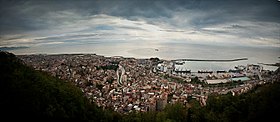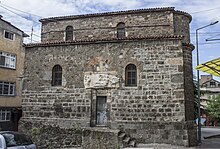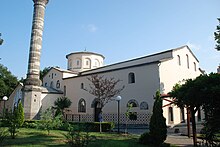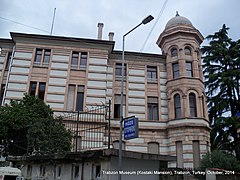Trabzon
Trabzon | ||
|---|---|---|
City | ||
|
Clockwise from top: Sumela Monastery viewed from across the Altındere valley; Lake Uzungöl; Atatürk Square; a general view of the city centre from Boztepe; Hagia Sophia of Trabzon; and Atatürk's House | ||
|
Licence plate 61 | | |
| Climate | Cfa | |
| Website | www www | |
Trabzon, historically known as Trebizond, is a city on the
Name

The Turkish name of the city is Trabzon. It is historically known in English as Trebizond. The first recorded name of the city is the Greek Tραπεζοῦς (Trapezous), referencing the table-like central hill between the Zağnos (İskeleboz) and Kuzgun streams on which it was founded (τράπεζα meant "table" in
In Spanish the name was known from chivalric romances and Don Quixote. Because of its similarity to trápala and trapaza,[10] trapisonda acquired the meaning "hullabaloo, imbroglio".[11]
History
Iron Age and Classical Antiquity
Before the city was founded as a Greek colony the area was dominated by
The city was founded in

Trebizond was the first Greek city the Ten Thousand reached on their retreat from Persia. 19th c. illustration by Herman Vogel.
Trebizond's trade partners included the
Up until the conquests of Alexander the Great the city remained under the dominion of the Achaemenids. While the Pontus was not directly affected by the war, its cities gained independence as a result of it. Local ruling families continued to claim partial Persian heritage, and Persian culture had some lasting influence on the city; the holy springs of Mt. Minthrion to the east of the old town were devoted to the Persian-Anatolian Greek god Mithra. In the 2nd century BC, the city with its natural harbours was added to the Kingdom of Pontus by Pharnaces I. Mithridates VI Eupator made it the home port of the Pontic fleet, in his quest to remove the Romans from Anatolia.
After the defeat of Mithridates in 66 BC, the city was first handed to the
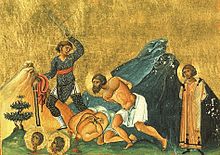

Septimius Severus punished Trebizond for having supported his rival Pescennius Niger during the Year of the Five Emperors. In 257 the city was pillaged by the Goths, despite reportedly being defended by "10,000 above its usual garrison" and two bands of walls.[16] Trebizond was subsequently rebuilt, pillaged again, by the Persians, in 258, and then rebuilt once more. It did not soon recover. Only in the reign of Diocletian does an inscription allude to the restoration of the city; Ammianus Marcellinus had nothing to say of Trebizond except that it was "not an obscure town."
Byzantine period
By the time of
The city regained importance when it became the seat of the theme of
Following the
Empire of Trebizond
The
(now Ayasofya mosque & museum)
(now Yeni Cuma Mosque)

Geographically, the Empire of Trebizond consisted of little more than a narrow strip along the southern coast of the
Together with Persian goods, Italian traders brought stories about the city to Western Europe. Trebizond played a mythical role in European literature of the late Middle Ages and the Renaissance.
The city also played a role in the early
The
In 1340, Tur Ali Beg, early ancestor of the Aq Qoyunlu raided Trebizond. In 1348, he besieged Trebizond, however he failed and lifted the siege. Later on, Alexios III of Trebizond gave his sister to Kutlu Beg son of Tur Ali Beg, and established a kinship with them.[32]
Constantinople remained the Byzantine capital until it was conquered by the Ottoman Sultan Mehmed II in 1453, who also conquered Trebizond eight years later, in 1461.
Its demographic legacy endured for several centuries after the Ottoman conquest in 1461, as a substantial number of
area to the southwest of the city. Compared to most previously Greek cities in Turkey, a large amount of its Greek Byzantine architectural heritage survives as well.Ottoman era
The last Emperor of Trebizond,
In 1598 it became the capital of its own province - the
Trebizond had a wealthy merchant class during the late Ottoman period, and the local Christian minority had a substantial influence in terms of culture, economy and politics. A number of European consulates were opened in the city due to its importance in regional trade and commerce. In the first half of the 19th century, Trebizond even became the main port for Persian exports. The opening of the
Next to Constantinople, Smyrna (now İzmir) and Salonika (now Thessaloniki), Trebizond was one of the cities where western cultural and technological innovations were first introduced to the Ottoman Empire. In 1835, the American Board of Commissioners for Foreign Missions opened the Trebizond Mission station that it occupied from 1835 to 1859 and from 1882 to at least 1892.[37] Hundreds of schools were constructed in the province during the first half of the 19th century, giving the region one of the highest literacy rates of the empire. First, the Greek community set up their schools, but soon the Muslim and Armenian communities followed. International schools were also established in the city; An American school, five French schools, a Persian school and a number of Italian schools were opened in the second half of the 19th century.[38] The city got a post office in 1845. New churches and mosques were built in the second half of the 19th century, as well as the first theater, public and private printing houses, multiple photo studios and banks. The oldest known photographs of the city center date from the 1860s and depict one of the last camel trains from Persia.
Between one and two thousand Armenians are believed to have been killed in the Trebizond vilayet during the Hamidian massacres of 1895. While this number was low in comparison to other Ottoman provinces, its impact on the Armenian community in the city was large. Many prominent Armenian residents, among them scholars, musicians, photographers and painters, decided to migrate towards the Russian Empire or France. The large Greek population of the city was not affected by the massacre.[39] Ivan Aivazovsky made the painting Massacre of the Armenians in Trebizond 1895 based on the events.[40] Due to the high number of Western Europeans in the city, news from the region was being reported on in many European newspapers. These western newspapers were in turn also very popular among the residents of the city.
Ottoman era paintings and drawings of Trebizond
-
Trebizond from the sea by Ivan Aivazovsky
-
Engraving of the port at Çömlekçi by C. Lapante
-
Trebizond by Jean-Baptiste Henri Durand-Brager
-
Trebizond from the sea by Yeghishe Tadevosyan
-
Trebizond from the south by Godfrey Vigne
-
The quarantine station by Jules Laurens
-
Street view by Nikolay Lanceray
Modern era
In 1901 the harbour was equipped with cranes by
In July 1915 most of the adult male Armenians of the city were marched off south in five convoys, towards the mines of Gümüşhane, never to be seen again. Other victims of the Armenian genocide were reportedly taken out to sea in boats which were then capsized.[42][43] In some areas of Trebizond province - such as the Karadere river valley in modern-day Araklı, 25 kilometers east of the city - the local Muslim population tried to protect the Christian Armenians.[44]
The coastal region between the city and the Russian frontier became the site of key battles between the Ottoman and
Chrysantos promised to protect the Muslim population of the city. Ottoman forces retreated from Trabzon, and on April 15 the city was taken without a fight by the
In early 1917 Chrysantos tried to broker a peace between the Russians and the Ottomans, to no avail. During the
In December 1918 Trabzon deputy governor
During the
The governor and mayor of Trebizond were appalled by the violence against Ottoman Greek subjects,
During the war Trebizond parliamentarian Ali Şükrü Bey had been one of the leading figures of the first Turkish opposition party. In his newspaper Tan, Şükrü and colleagues publicized critiques of the Kemalist government, such as towards the violence perpetrated against Greeks during the population exchange. Şükrü argued that recognition of ethnic diversity was not a threat to the Turkish nation.
Topal Osman's men would eventually murder parliamentarian Şükrü for his criticism of the nationalist government of Mustafa Kemal in March 1923. Topal Osman was later sentenced to death and killed while resisting arrest. After pressure from the opposition, his headless body was hanged by his foot in front of the Turkish parliament. Ali Şükrü Bey, who had studied in Deniz Harp Okulu (Turkish Naval Academy) and worked as a journalist in the United Kingdom, is seen as a hero by the people of Trabzon, while in neighboring Giresun there is a statue of his murderer Topal Osman. Three years later Trabzon deputy Hafız Mehmet - who had testified to his knowledge of, and opposition to, the Armenian Genocide - was also executed, for his alleged involvement in the İzmir plot to assassinate Mustafa Kemal. The literal decapitation of the Turkish political opposition - which was in large part based in the Trabzon region - decreased the city's national influence, and led to a long-standing animosity between the Kemalists and the population of Trabzon. A political and cultural divide between the Eastern Black Sea Region and the rest of Anatolia continued to exist throughout the 20th century, and still influences Turkish politics today. Even in the 21st century, politicians who hail from Trabzon are often faced with xenophobic attacks from both nationalist and conservative circles.[citation needed]
During World War II shipping activity was limited because the Black Sea had again become a war zone. Hence, the most important export products,
As a result of the general development of the country, Trabzon has developed its economic and commercial life. The coastal highway and a new harbour have increased commercial relations with central Anatolia, which has led to some growth. However, progress has been slow in comparison to the western and the southwestern parts of Turkey.
Trabzon is famous throughout Turkey for its
The city still has a sizable community of Greek-speaking Muslims, most of whom are originally from the vicinities of Tonya, Sürmene and Çaykara. However, the variety of the Pontic Greek language - known as "Romeika" in the local vernacular, Pontiaka in Greek, and Rumca in Turkish - is spoken mostly by the older generations.[51]
Geography and climate

Trabzon Province has a total area of 4,685 square kilometres (1,809 sq mi) and is bordered by the provinces of Rize, Giresun, and Gümüşhane. The total area is 22.4% plateau and 77.6% hills. The Pontic Mountains pass through the Trabzon Province.
Trabzon used to be an important
Trabzon has four lakes: Uzungöl, Çakırgöl, Sera, and Haldizen Lakes. There are several streams, but no rivers in Trabzon.
Climate
Trabzon has a climate typical of the eastern Black Sea region, a humid subtropical climate (Köppen: Cfa, Trewartha: Cf) near the coast.[52] A very small percentage of the province can be classified as subtropical, however, as slightly elevated rural areas near the coast are oceanic (Cfb/Do), the mountainous offshores are humid continental (Dfb/Dc) and subarctic (Dfc/Eo); and tundra (ET/Ft) can be found in the peaks of the Pontic Alps. Furthermore, during the time the Köppen climate classification was created, the city center had a borderline oceanic-humid subtropical climate, falling just under the 22 °C (72 °F) threshold for the hottest month of the year, yet climate change and the city's urban heat island contributed to its reclassification as humid subtropical in recent decades. This and the fact that the subtropical microclimate zone along the shore occupies a very narrow band due to the continuous parallel mountain range starting right at the coast is why local authorities still classify the city as oceanic, as this climate subtype is better representative of the entire coastal region of the province.[53][54]
Summers are warm, the average maximum temperature is around 28 °C (82 °F) in August, while winters are generally cool, the lowest average minimum temperature is almost 5 °C (41 °F) in February. Precipitation is heaviest in autumn and winter, with a marked reduction in the summer months, a microclimatic condition of the city center compared to the rest of the region.[55] Snowfall is somewhat common between the months of December and March, snowing for a week or two, and it can be heavy once it snows.
The water temperature, like in the rest of the Black Sea coast of Turkey, is generally mild, and fluctuates between 8 °C (46 °F) and 20 °C (68 °F) throughout the year.
| Climate data for Trabzon (1991–2020, extremes 1927–2020) | |||||||||||||
|---|---|---|---|---|---|---|---|---|---|---|---|---|---|
| Month | Jan | Feb | Mar | Apr | May | Jun | Jul | Aug | Sep | Oct | Nov | Dec | Year |
| Record high °C (°F) | 25.9 (78.6) |
30.1 (86.2) |
35.2 (95.4) |
37.6 (99.7) |
38.2 (100.8) |
36.7 (98.1) |
37.0 (98.6) |
38.2 (100.8) |
37.9 (100.2) |
33.8 (92.8) |
32.8 (91.0) |
26.4 (79.5) |
38.2 (100.8) |
| Mean daily maximum °C (°F) | 11.3 (52.3) |
11.4 (52.5) |
13.0 (55.4) |
16.3 (61.3) |
20.0 (68.0) |
24.5 (76.1) |
27.5 (81.5) |
28.1 (82.6) |
25.1 (77.2) |
21.0 (69.8) |
16.5 (61.7) |
13.1 (55.6) |
19.0 (66.2) |
| Daily mean °C (°F) | 7.7 (45.9) |
7.5 (45.5) |
9.2 (48.6) |
12.2 (54.0) |
16.4 (61.5) |
20.9 (69.6) |
23.8 (74.8) |
24.4 (75.9) |
21.1 (70.0) |
17.2 (63.0) |
12.7 (54.9) |
9.5 (49.1) |
15.2 (59.4) |
| Mean daily minimum °C (°F) | 5.0 (41.0) |
4.6 (40.3) |
6.2 (43.2) |
9.0 (48.2) |
13.4 (56.1) |
17.6 (63.7) |
20.6 (69.1) |
21.2 (70.2) |
17.8 (64.0) |
14.1 (57.4) |
9.6 (49.3) |
6.8 (44.2) |
12.2 (54.0) |
| Record low °C (°F) | −7.0 (19.4) |
−7.4 (18.7) |
−5.8 (21.6) |
−2.0 (28.4) |
4.2 (39.6) |
9.2 (48.6) |
11.0 (51.8) |
13.5 (56.3) |
7.3 (45.1) |
3.4 (38.1) |
−1.6 (29.1) |
−3.3 (26.1) |
−7.4 (18.7) |
| Average precipitation mm (inches) | 88.8 (3.50) |
63.1 (2.48) |
69.3 (2.73) |
62.8 (2.47) |
55.5 (2.19) |
52.3 (2.06) |
34.7 (1.37) |
59.4 (2.34) |
85.4 (3.36) |
134.1 (5.28) |
103.2 (4.06) |
93.5 (3.68) |
902.1 (35.52) |
| Average precipitation days | 10.82 | 9.68 | 11.09 | 11.32 | 11.00 | 9.95 | 7.32 | 9.32 | 9.64 | 11.27 | 9.27 | 10.64 | 121.3 |
| Average relative humidity (%)
|
69 | 69 | 73 | 75 | 77 | 75 | 73 | 73 | 74 | 73 | 70 | 68 | 72 |
| Mean monthly sunshine hours | 71.3 | 84.8 | 99.2 | 135.0 | 170.5 | 192.0 | 176.7 | 151.9 | 147.0 | 127.1 | 105.0 | 65.1 | 1,525.6 |
| Mean daily sunshine hours | 2.3 | 3.0 | 3.2 | 4.5 | 5.5 | 6.4 | 5.7 | 4.9 | 4.9 | 4.1 | 3.5 | 2.1 | 4.2 |
| Source 1: Turkish State Meteorological Service[56] | |||||||||||||
| Source 2: Weatherbase[57][58] | |||||||||||||
Economy
As of 1920, the port at Trabzon was considered "the most important of the Turkish Black Sea ports" by the
Trabzon produced a white green bean, which was sold in Europe. It was, as of 1920, the only vegetable exported out of the province.[61] Poultry farming was also popular in Trabzon. Sericulture was seen in the area before 1914.[63] The area produced copper, silver, zinc, iron and manganese. Copper was kept for local use by coppersmiths. During the Balkan Wars production ceased due to poor exportation and fuel supplies.[64]
Trabzon Airport opened in 1957.
People
History
Trebizond was an overwhelmingly Christian and Greek city at the time of its fall to the Ottomans in 1461. The Greek Christians slowly lost their majority through the end of that century. Initially, the Muslims were mainly immigrants from Anatolia with a minority of local converts, but this quickly changed with the emergence of an active missionary spirit in the 16th century, as mosques and dervish lodges were built in predominantly Christian neighborhoods.[65]


Laz people also live in Trabzon. Numerous villages inside and out of Trabzon of the Laz date back as early as the period of Queen Tamar's rule (Georgian: თამარი, also transliterated as T'amar or Thamar; c. 1160 – 18 January 1213) in the newly unified Kingdom of Georgia. During the Queen's rule, sizeable groups of immigrating Georgians moved to Trabzon where they continue to preserve their native tongue. There was an Armenian community in Trebizond as early as the 7th century.[66]
During the 13th and 14th centuries, numerous Armenian families migrated there from Ani.[66] Robert W. Edwards published part of an early 15th-century diary from the Castilian ambassador who visited Trabzon and compared the churches of the Greek and Armenian communities.[67] It was stated by the ambassador that the Armenians, who were not well-liked by the Greeks, had a population large enough to support a resident bishop. According to Ronald C. Jennings, in the early 16th century, Armenians made up approximately 13 percent[68] of the city's population.[69] At present, Trabzon does not have an Armenian-speaking community.
The
It is possible that the majority of the population of Trabzon and
Urbanization
| Population | 2007 | 2008 | 2009 | 2010 | 2011 | 2012 | 2013 | 2014 | 2015 |
|---|---|---|---|---|---|---|---|---|---|
| Total | 740,569 | 748,982 | 765,127 | 763,714 | 757,353 | 757,898 | 758,237 | 766,782 | 768,417 |
| Urban | 396,646 | 390,797 | 408,103 | 415,652 | 757,353 | 757,898 | 758,237 | 766,782 | 768,417 |
Main sights
Trabzon has a number of tourist attractions, some of them dating back to the times of the
- The Hagia Sophia (formerly Turkish: Ayasofya Müzesi, now a mosque), a stunning Byzantine church, is probably the town's most important tourist attraction.
- Trabzon Castleruins are visible in the town but cannot be visited as they fall in a military zone. The outside wall of the castle now serves as the back wall of a military building.
- The "Atatürk Köşkü" is a villa built in 1890 by a local Greek merchant. In 1924 Mustafa Kemal Atatürk stayed in the villa during his visit to Trabzon. He stayed there again in 1937. It houses period rooms and serves as a monument to the memory of the founder and first president of the Republic of Turkey.
- Boztepe Parkis a small park and tea garden on the hills above Trabzon that has a panoramic view of nearly the entire city. The terrain in Trabzon is ascending in such a way that although the view is far above that of the buildings below, it is still close enough to be able to observe the flow of traffic and the people moving about in the city.
- Uzun Sokak is one of the most crowded streets of Trabzon.
- Trabzon Museum is located in the town centre and offers interesting exhibits on the history of the region, including an impressive collection of Byzantine artifacts.
- Trabzon's Bazaar District offers interesting shopping opportunities on ancient narrow streets, continuing from Kunduracılar Street from the Meydan (town square).
- Saint Anne Church, Trabzon, is located in the city centre of Trabzon, and one of the oldest in the city.
- Kostaki Mansion is located to the north of Zeytinlik, near Uzun Sokak.
- Uzungöl Dursun Ali İnan Museum An ethnographic museum in Uzungolthat tells the history of Trabzon and the region.
Other sites of the city include:
Within
- Kaymaklı Monastery, a formerly Armenian Monastery of the All-Saviour (arm. Ամենափրկիչ Վանք, Amenaprgič Vank);
- Kızlar Monasteryof Panagia Theoskepastos (the God-veiled Virgin);
- Kuştul Monastery of Gregorios Peristereotas (gr. Ιερά Μονή του Αγίου Γεωργίου Περιστερεώτα, Ierá Moní tou Agíou Georgíou Peristereóta);
- Vazelon Monastery of Agios Savvas (Maşatlık);
- Cave churches of Agia Anna (Little Ayvasıl), Sotha (St. John), Agios Theodoros, Agios Konstantinos, Agios Christophoros, Agia Kyriakí, Agios Michail, and Panagia Tzita churches.[75]
Culture

Folk dancing is still very much in evidence in the
The people of Trabzon have a reputation for being religiously conservative and nationalist. Many Trabzonites generally show a strong sense of loyalty to their family, friends, religion and country. Atatürk selected his presidential guards from Trabzon and the neighbouring city of Giresun because of their fierce fighting ability and their loyalty.
Outside of the relatively urban space of Trabzon proper, and within parts of it as well, rural traditions from the Black Sea village life are still thriving. These include traditional gender roles, social conservatism, hospitality, and a willingness to help strangers; and all aspects, both positive and negative, of an agrarian lifestyle, such as hard work, poverty, strong family ties, and a closeness to nature.
The people of the eastern Black Sea region are also known for their wit and sense of humour; many jokes in Turkey are told about the natives of the Black Sea region Karadeniz fıkraları (Black Sea jokes). The character Temel, a universal buffoon figure found in many cultures, forms an important part of the Turkish oral tradition.
The city's profile was raised somewhat in the English-speaking world by Dame Rose Macaulay's last novel, The Towers of Trebizond (1956), which is still in print.[77]
Education
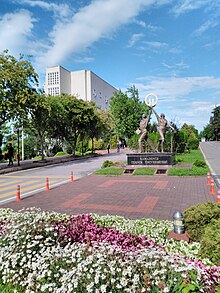
Historically the city was a center of Greek culture and education and from 1683 to 1921, a teachers' college operated known as Phrontisterion of Trapezous, which provided a major impetus for the rapid expansion of Greek education throughout the region.[78] The building of this institution (built in 1902) still remains the most impressive Pontic Greek monument in the city and today hosts the Turkish school Anadolu Lisesi.[79]
Cuisine
Trabzon's regional cuisine is traditionally reliant on fish, especially hamsi (fresh
Sports


Football is the most popular sport in Trabzon. The city's top sports club, Trabzonspor, was until 2010 the only Turkish football club outside İstanbul to win the Süper Lig (six times), which was previously (until Trabzonspor's first championship title in the 1975–76 season) won only by the "Big Three" clubs of Istanbul, namely Galatasaray, Fenerbahçe, and Beşiktaş. Due to Trabzonspor's success, the decades-old term "Big Three" which defined the most successful football clubs in Turkey had to be modified into the "Big Four". Trabzonspor is also one of the most successful Turkish clubs in the European Cups, managing to beat numerous prominent teams such as Barcelona, Inter, Liverpool, Aston Villa, and Olympique Lyonnais. Renowned former players of Trabzonspor include Şenol Güneş, Lars Olsen, and Shota Arveladze. In the 2021–2022 season, Trabzonspor left their Istanbul competition far behind, securing an early championship and ending a 38-year dry streak. Hundreds of thousands Trabzonite expatriates and fans from around the globe made their way to the city to participate in one of the first mass gatherings in the country for nearly two years, marking the end of the Corona pandemic. Officially the pandemic-measures had not been fully lifted, which led to some criticism towards the city's municipal government for allowing the festivities to continue for hours into the night, long past curfew.
Trabzon hosted the first edition of the Black Sea Games in July 2007 and the 2011 European Youth Summer Olympic Festival.
Notable residents
International relations
Twin towns - sister cities
Trabzon is
See also
- Amaseia, capital of the Pontic Greeks during classical antiquity)
- Anatolian Tigers
- Black Sea Region
- Kemençe of the Black Sea
- Kolbastı
- World Trade Center Trabzon
- Capture of Trabzon
Notes and references
- ^ "Trabzon". citypopulation.de. Retrieved 23 January 2024.
- ^ Trabzon (tr) Archived 2011-11-03 at the Wayback Machine
- ^ ISBN 978-1-110-86390-7.
- ^ Campbell, Lawrence Dundas, The Asiatic annual register, or, A View of the history of Hindustan, and of the Politics, Commerce, Literature of Asia, London 1802 Page 3, Google books link
- ^ Malte-Brun, Conrad, Universal geography: or a description of all parts of the world ..., Volume 2 Google Books
- ^ "The modern traveller, a popular description geographical, historical, and topographical of the varieus countries of the globe". J. Dunkan. 14 January 2018. Retrieved 14 January 2018 – via Google Books.
- ISBN 9783111959979. Retrieved 14 January 2018 – via Google Books.
- ^ Y.Dutxuri. "Türkçe Lazca sözlük / Çeviri / Online Çeviri / Lazuri.Com". www.Lazuri.com. Retrieved 14 January 2018.
- ISBN 978-605-54-1017-9
- ISBN 84-249-0879-1.
- ^ trapisonda en Diccionario de la Real Academia Española (in Spanish) (23rd ed.). 2019. Retrieved 24 July 2020.
- ^ Phoenix: The Peoples of the Hills: Ancient Ararat and Caucasus by Charles Burney, David Marshall Lang, Phoenix Press; New Ed edition (December 31, 2001)
- ISBN 0-253-20915-3, page 45
- ^ "A Star in the East". TimothyGrove.Blogspot.ro. 23 July 2012. Retrieved 14 January 2018.
- OCLC 1299382109.
- ^ a b William Miller, Trebizond: The Last Greek Empire, 1926, (Chicago: Argonaut Publishers, 1968), p. 9
- ^ Miller, Trebizond, p. 10
- ^ a b c Hewsen, 46
- ^ a b Miller, Trebizond, p. 11
- ^ Calzolari, V. "The Armenian translation of the Greek Neoplatonic Works" in Greek Texts and Armenian Traditions: An Interdisciplinary Approach, 2016, p. 51
- ^ R.B. Serjeant, Islamic Textiles: material for a history up to the Mongol conquest, 1972, pp 63, 213, noted by David Jacoby, "Silk Economics and Cross-Cultural Artistic Interaction: Byzantium, the Muslim World, and the Christian West", Dumbarton Oaks Papers 58 (2004:197–240) p. 219 note 112.
- ^ Speros Vryonis, The Decline of Medieval Hellenism in Asia Minor and the Process of Islamization from the Eleventh through the Fifteenth Century (Berkeley: University of California, 1971), p. 16
- ^ Robert W. Edwards, "The Garrison Forts of the Pontos: A Case for the Diffusion of the Armenian Paradigm", Revue des Études Arméniennes 19, 1985, pp.181–284.
- ^ Miller, Trebizond, p. 12
- ^ Bendall, "The Mint of Trebizond under Alexius I and the Gabrades", Numismatic Chronicle, Seventh Series, 17 (1977), pp. 126–136
- ^ A. A. Vasiliev, "The Foundation of the Empire of Trebizond (1204–1222)", Speculum, 11 (1936), pp. 18f
- ^ Finlay, George. The History Of Greece From Its Conquest By The Crusaders To Its Conquest By The Turks And Of The Empire Of Trebizond, 1204–1461, By George Finlay. 1st ed. Edinburgh: W. Blackwood and sons, 1851. Print.
- ^ Vasilev, A. A. The Foundation Of The Empire Of Trebizond 1204–1222. 1st ed. Cambridge, Mass.: Medieval Academy of America, 1936. Print.
- ^ 'The lure of Trebizond' by Anthony Eastmond, in Byzantium's Other Empire: Trebizond, p. 22, 2016, Istanbul
- ^ "Shams al‐Dīn al‐Bukhārī". Thomas Hockey et al. (eds.). The Biographical Encyclopedia of Astronomers. New York: Springer, 2007, pp. 1047–1048. Retrieved 12 January 2018.
- ^ Astronomy in the Trebizond Empire Ahmet M. Zehiroğlu (trans. by Paula Darwish). from Trabzon İmparatorluğu 2016, Trabzon.
- TDV Encyclopedia of Islam (44+2 vols.) (in Turkish). Istanbul: Turkiye Diyanet Foundation, Centre for Islamic Studies.
- ^ Prothero, G.W. (1920). Anatolia. London: H.M. Stationery Office.
- ^ a b The Armenian People from Ancient to Modern Times, Richard G. Hovannisian, page 27/28, 2004
- ^ "Haber Yazdır : Trabzon'un fethi araştırmaları ve 15 ağustos 1461 – Of hayrat haberleri". www.OfHayrat.com. Retrieved 14 January 2018.
- ISBN 978-0-8021-1686-4. At pages 12-13.
- ^ Rev. M. P. Parmalee (1892). Proceedings of the ABCFM for the year 1892. Boston: Samuel Usher. p. 229. Retrieved 1 May 2017.
Trebizond was occupied as a missionary station in 1835... The following is a list of missionaries who have been connected with the station for at least one year: ... Rev. G. W. Wood, 1842 – 1843"
- ^ The constitutional revolution of 1908 and its aftermath in Trabzon Ahmetoglu, S., 2019, p.127-128, Doctoral Thesis, Leiden University
- ^ Rev. Edwin Munsell Blis on the Hamidian Massacres in 'Modern Genocide: The Definitive Resource and Document Collection', 2014, p. 147, Paul R. Bartrop & Steven Leonard Jacobs (eds)
- doi:10.4000/eac.1815.
- ^ Daniel Maldonado in 'Historic Cities of the Islamic World', 2007, p. 525, C. Edmund Bosworth (ed)
- ^ Toronto Globe, August 26, 1915.
- ^ Takvimi Vekdyi, No. 3616, August 6, 1919, p. 2.
- ^ KAZA HEMŞIN / ՀԱՄՇԷՆ – HAMSHEN Virtual genocide memorial
- ^ Infographic by the newspaper The Sphere showing the advance of the Russian front on Trebizond, The Sphere, April 29, 1916
- ^ "Massacre of Christians before Evacuation of Trebizond". Adelaide, Australia: The Daily Herald. April 21, 1916. p. 5.
Frightful scenes were witnessed in the Christian quarter...hundreds of civilians were killed.
- ^ Grand Larousse encyclopedia Turkish edition, 22, page: 11669, Librairie Larousse
- ^ Seattle City Council and Asia Minor – The articles of Herbert Adams Gibbons in the Christian Science Monitor Stavros T. Stavridis in The National Herald, September 26, 2017
- ISBN 9780674023680. Retrieved 15 January 2018 – via Google Books.
- ISBN 978-3-902005-62-5. "On October 11, 1922, Turkey concluded an armistice with the allied forces, but not with the Greeks. The Greeks in the other settlement areas of Asia Minor were also expelled at that time, like e.g. the Kappadocian Greeks in the Goreme area and the other Greeks in Pontus, in the Trebizond area and on the west coast."
- ISBN 978-605-54-1017-9; Peter Mackridge: Greek-Speaking Muslims of North-East Turkey: Prolegomena to a study of the Ophitic sub-dialect of Pontic, Byzantine and Modern Greek Studies, Oxford University Press, 1987, pp. 115–137; Ömer Asan: Pontus Kültürü, Belge Yayınları, Istanbul, 1996.
- .
- ^ "Türkiye İklimi". Meteoroloji Genel Müdürlüğü. 27 May 2021.
- ^ "File:Koppen-Geiger Map TUR present.svg - Wikipedia". commons.wikimedia.org. 6 November 2018. Retrieved 2020-11-07.
- ^ "Meteorolojik Parametrelerin Türkiye'de Analizi". Meteoroloji Genel Müdürlüğü. 27 May 2021.
- ^ "Resmi İstatistikler: İllerimize Ait Genel İstatistik Verileri" (in Turkish). Turkish State Meteorological Service. Retrieved 26 June 2021.
- ^ "Trabzon, Turkey Travel Weather Averages (Weatherbase)". Weatherbase. Retrieved 14 January 2018.
- ^ "17038: Trabzon (Turkey)". OGIMET. 13 January 2021. Retrieved 14 January 2021.
- ^ Prothero, W.G. (1920). Armenia and Kurdistan. London: H.M. Stationery Office. p. 51.
- ^ Prothero, W.G. (1920). Armenia and Kurdistan. London: H.M. Stationery Office. p. 52.
- ^ a b Prothero, W.G. (1920). Armenia and Kurdistan. London: H.M. Stationery Office. p. 61.
- ^ Prothero, W.G. (1920). Armenia and Kurdistan. London: H.M. Stationery Office. p. 60.
- ^ Prothero, W.G. (1920). Armenia and Kurdistan. London: H.M. Stationery Office. p. 64.
- ^ Prothero, W.G. (1920). Armenia and Kurdistan. London: H.M. Stationery Office. p. 73.
- ISBN 9780748694006. Retrieved 5 June 2023.
- ^ OCLC 10431241.
- ^ Robert W. Edwards, "Armenian and Byzantine Religious Practices in Early Fifteenth-Century Trabzon: A Spanish Viewpoint", Revue des Études Arméniennes 23, 1992, pp. 81–90.
- ^ 15.5% of 85%
- ^ Jennings, Ronald C. (Jan. 1976) Urban Population in Anatolia in the 16th Century: International Journal of MiddleEast Studies, Vol. 7, No. 1 pp. 21–57.
- ^ Bernt Brendemoen, The Turkish dialects of Trabzon, University of Oslo, 2002 p. 18
- ^ Professor. Department of Near Eastern Studies. Princeton University
- ISBN 975-518-116-4
- ^ Michael Meeker, "The Black Sea Turks: some aspects of their ethnic and cultural background", International Journal of Middle East Studies (1971) 2:318–345
- ^ Meeker, 1971: p. 326 "As the mentioned, the villages along the Black Sea coast from Ordu to Artvin are composed of many hamlets, each dominating a hilltop or mountainside on which its own crops are separately planted. This type of settlement pattern is in sharp contrast with the typical nucleated Anatolian village, but its characteristic of many rural settlements of the Western Caucasus notably those of Abkhaz, Circassians, Georgians, Mingrelians, and Ossetes..."
For similar ideas See: Karl Koch, Reise duch Russland nach dem Kaukasis chen Istmus in den Jahren, 1836. vol1. p. 378; W.E.D. Allen, A History of the Georgian People, London 1932. pp. 54–5; Özhan Öztürk, Karadeniz. 2005. p. 35, 757–68. For linguistic influence see: Bernt Brendomoen, Laz influence on the Black Sea Turkish Dialects, 1990 (Proceedings from 32nd meeting of the Permanent International Altaistic Conference) - ^ Karalahana.com Archived 2008-06-11 at the Wayback Machine
- ^ People and culture of Trabzon and Black sea region Archived 2010-02-10 at the Wayback Machine
- ^ Macaulay, Rose: The Towers of Trebizond (Collins, London, 1956)
- ISBN 978-0-415-34164-6.
- ISBN 978-0-86078-864-5.
- ^ "Kardeş Şehirler". trabzon.bel.tr (in Turkish). Trabzon. Retrieved 2020-01-17.
Further reading
- Bryer, Anthony; David Winfield (March 1985). Byzantine Monuments and Topography of the Pontos (Dumbarton Oaks Studies,20) Two Volume Set. Dumbarton Oaks Pub Service. ISBN 0-88402-122-X.
- Nystazopoulou, Marie (1964). "La dernière reconquête de Sinope par les Grecs de Trébizonde (1254–1265)". .
- Schliefer, Yigal (2007-01-26). "Turkish city grapples with violent record". Christian Science Monitor.
- Arsu, Sebnem (2007-02-08). "Suspects in Journalist's Killing Came From a Hotbed of Turkish Ultranationalist Sentiment". New York Times.
- ISBN 975-6121-00-9
- Richard Stillwell; William L. MacDonald; Marian Holland McAllister (eds.). "Trapezus". Princeton Encyclopedia of Classical Sites.






